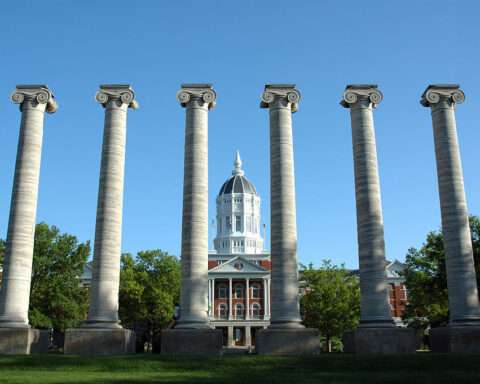The Red River of the North runs 400 miles through the north-central United States, forming most of the border between Minnesota and North Dakota before flowing into Canada and ultimately Lake Winnipeg.
The river valley is one of the most flood-prone areas in the U.S., particularly in the spring when snowmelt fails to penetrate soil hardened by deep frost lines, and ice flows and jams clog waterways.
Almost every year, the area around Fargo, North Dakota, and Moorhead, Minnesota, bears the brunt of that flooding, which causes millions of dollars in damage. Flood-control measures throughout the 1900s involved ditches, levees and a watershed approach ,but they were often not enough to hold back floodwaters.
In 2013, city, county and regional stakeholders formed an entity that is now working with the U.S. Army Corps of Engineers through a private-public partnership (P3) to build, finance, operate and maintain permanent flood protection in the area.
The initiative – called the Fargo-Moorhead River Flood Diversion P3 Project – involves building a 30-mile-long diversion channel to the west of Fargo that will redirect surplus stormwater around the metropolitan area and temporarily store it on vacant land.
It is one of four water infrastructure projects that are moving forward via a P3 pilot program that could save more than $610 million in federal funds.
The U.S. Army Corps of Engineers (USACE) launched the P3 pilot program in 2019 as another funding mechanism to accelerate projects in the Corps-authorized portfolio that improve waterways and ports. This includes projects that would reduce flood damage and improve ecosystems.
“The goal is just to encourage innovation and streamline delivery practices for our infrastructure projects,” said Aaron Snyder, director of the Corps Water Infrastructure Financing Program (CWIFP).
Kevin Denn, project manager with the USACE St. Paul District, said the Fargo-Moorhead project is being completed as a split delivery in which all construction pieces are moving forward simultaneously. The local entity, spearheaded by a newly created Metro Flood Diversion Authority, is constructing the northern part of the project while the USACE is building the southern portion.
The contractor has been able to innovate by having crews work 24/7, even through the winter when it is easier to excavate the frozen ground, Denn said.
“They realize that winter is actually the time where they can make a lot of their big progress,” he said. “That’s been a kind of a flip to a lot of the work that the Corps of Engineers is doing. … A lot of our efforts are going on during the summer while we’re building the dam.”
Construction began in 2022 and is expected to be completed by 2027. The P3 program is estimated to save $330 million in construction costs and accelerate the program by 10 years.
A quicker, more efficient model
P3s are a contracting approach that can deliver projects more efficiently, Snyder said. With larger projects, they are often split into multiple smaller contracts through a more traditional design-bid-build process.
Through the P3 structure, the USACE can partner with local entities and private firms to finance, design, build, operate and maintain projects. Work can be completed more quickly with one larger contract or larger groupings of contracts, Snyder said.
“You get economy of scale, you get efficiency in the contracting process, but what you also do is you transfer the risk and ability for the developer to innovate,” he said. “The contractor has some responsibility. They don’t get as much oversight, per se, but there’s still plenty of oversight. And they’re responsible to deliver consistent with what the contract says.”
In addition to Fargo-Moorhead, one other project is under construction: the Brazos Island Harbor Channel Improvement. This project will deepen the shipping channel in the Port of Brownsville, Texas, by 10 feet as well as excavate areas for ships to dock. The project will save about $72 million and accelerate the project by about three years.
Two others are in development:
- Los Angeles River Ecosystem Restoration Project: This will improve water quality and the river’s ecosystem along 11 miles near downtown Los Angeles. The project is estimated to save $87 million in federal costs.
- Denver South Platte Ecosystem Restoration and Flood Risk Management: This will restore aquatic life in several waterways in Denver. The project is estimated to save between $121 million to $194 million and accelerate the construction by two to five years.
“We’re looking at average cost savings of about 20%. And then we’ve been able to decrease the time of delivery by nearly 50% in some cases,” Snyder said. “So it’s a significant cost and time savings, but it’s going to vary based on each individual project.”
Since launching the P3 program, the criteria for eligible projects to be considered have shifted, Snyder said. The P3 mechanism typically works better with larger projects, ideally costing $200 million or more, he said. Projects also need strong local support.
“You really have to have a strong local partner, somebody that really wants the project, and they want to get this project done—it is more important to them than it is to the Corps of Engineers,” he said.
USACE can participate in seven additional P3 pilot program projects and is actively seeking applications. Criteria include:
- Construction costs over $50 million;
- Securing non-federal support;
- Capacity to accelerate construction;
- Ability to generate revenue or use non-federal dollars; and
- Prove the P3 mechanism is faster than traditional funding sources.
“I just really think that [P3] is something that the U.S. needs to focus more on,” Snyder said. “We need to really try to move our communities away from design-bid-build, in some instances where it makes sense. Getting the right people to the table to be able to explore those opportunities is what needs to happen.”
This story has been corrected to clarify the P3 Pilot Program.












